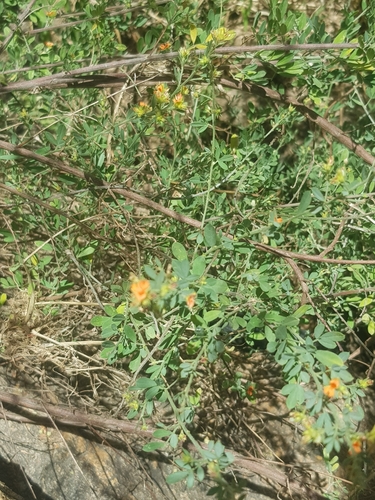Indigofera pulchra.

|
|
Scientific
Classification:
Synonyms:
Species ID: NMP-218;wfo-0000194692;NCBI_Taxonomy ID: 539139 Local
Names: Common
Names: Senegal: Mankanya bi diangal (JB), Wolof mbun (JLT; JB). Sierra Leone: Mende njamumwi (NWT), Temne balkeyan (NWT). Nigeria: Birom romo (LB), Hausa bakin buunuu = black 'buunun' (auctt.), namijin babar (RES), Yoruba ejaomode (Millen; JMD) Description: Indigofera pulchra is an
erect, stiff, grey-pubescent, softly woody undershrub that can grow up to 1.5
meters in height. The plant exhibits considerable variation, especially in the
extent to which the leaves are divided. The leaves are usually dimorphic, with
the upper ones being 1–3-foliolate and the lower ones up to 11-foliolate. The
inflorescences are terminal racemes, sometimes condensed and subcapitate, with
flowers that have a brownish calyx and a corolla that is red to orange. The
fruit is a pod, approximately 4 mm long, pubescent, and typically contains two
seeds.
This
species is native to tropical Africa, with a distribution that includes
countries such as Nigeria, Ghana, Senegal, and Tanzania. It thrives in
seasonally dry tropical biomes, often found in savannas and open woodlands. Medicinal
Properties:
Indigofera pulchra has been utilized in traditional medicine. In certain
regions, it is used for its medicinal properties, although specific
applications are not well-documented in the available literature. Known
Toxicity: There is
limited information regarding the toxicity of Indigofera pulchra. While
it is used in traditional medicine, caution is advised, and further research is
necessary to fully understand its safety profile. Additional
Information:
The genus Indigofera comprises over 750 species, many of which are known
for producing the indigo dye. However, Indigofera pulchra is not
specifically noted for dye production. The plant's adaptability to seasonally
dry environments makes it a resilient species within its native range. References:
External
Links
|
|
| Compounds of Indigofera pulchra. | |
| References |